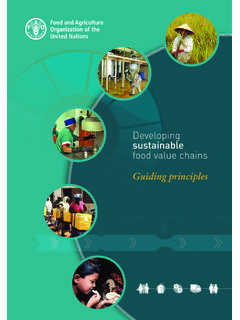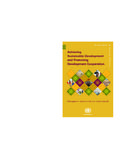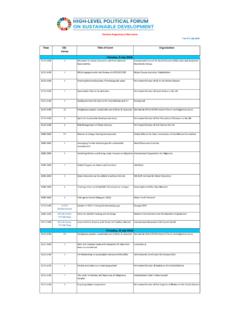Transcription of “Packaging Logistics” for improving performance in …
1 Production, 26(2), 261-272, 2016doi: IntroductionNowadays, supply chain executives should increase efforts to improve competitiveness and sustainability by eliminating activities that do not add value and by developing innovations in processes and products (Christopher, 2005; Andersen & Skjoett-Larsen, 2009; Garc a-Arca et al., 2011). Simultaneously, different stakeholders show a growing interest in the sustainability of supply chains (Seuring & M ller, 2008; Andersen & Skjoett-Larsen, 2009). Seuring & M ller (2008) show the potential outcomes from developing a sustainable supply chain in terms of environmental, economic and social development: it saves resources, reduces waste, and provides competitive this scenario of pursuing sustainability and efficiency throughout the supply chain, companies should develop actions that impact positively both strategic as well as operational aspects of the processes (framed in the logistic activities of supplying, production, physical distribution and reverse logistics).
2 Past research ( , Saghir & J nson, 2001; Klevas, 2005; Hellstr m & Saghir, 2006; Verghese & Lewis, 2007; Garc a-Arca & Prado-Prado, 2008a; Azzi et al., 2012; Garc a-Arca et al., 2014) consider packaging as one of the key and global elements that support an efficient and sustainable supply chain. These authors show that supply chain companies have different requirements with regard to packaging. Such requirements are not distributed homogeneously in the different levels of packaging (primary, secondary and tertiary levels), and require that packaging, logistics, and product aspects be context has led to the development of the concept of packaging logistics . Saghir (2004, p. 6) presents the concept of Packaging Logistics as Received: Sept. 9, 2014; Accepted: Oct. 10, 2015 Packaging Logistics for improving performance in supply chains: the role of meta-standards implementationJes s Garc a-Arcaa*, Alicia Trinidad Gonz lez-Portela Garridob**, Jos Carlos Prado-Pradoa**aIndustrial Engineering School, University of Vigo, Vigo, SpainbBusiness Administration School, University of Vigo, Vigo, packaging design process arises as one key factor that could contribute to increasing the efficiency and sustainability of supply chains.
3 This approach is called packaging logistics . Another managerial approach that is related to efficiency and sustainability is the implementation of meta-standards (ISO 9000 and ISO 14000). As both packaging logistics and meta-standards can contribute positively towards supply chain efficiency and sustainability, it becomes relevant to examine the relationship between them. In this study, we explore the potential relation between meta-standards (ISO 9000 and ISO 14000) and the implementation of the key aspects of packaging logistics . In addition, we explore the relation between packaging logistics and aspects of performance . This is accomplished through an exploratory study of the packaging design process of Spanish manufacturers in the food Supply chain. Logistics. ISO 9000. ISO 14000. Packaging Logistics for improving .. role of meta-standards implementation. Production, 26(2), 261-272, 2016262 Garc a-Arca, J. et al.[..] the process of planning, implementing and controlling the coordinated packaging system of pre-paring goods for safe, secure, efficient and effective handling, transport, distribution, storage, retailing, consumption and recovery, reuse or disposal and related information combined with maximizing consumer value, sales and hence further, Garc a-Arca et al.
4 (2014, p. 330) propose a wider definition, introducing the concept of sustainable packaging logistics as [..] the process of designing, implementing, and controlling the integrated packaging, product and supply chain systems in order to prepare goods for safe, secure, efficient and effective handling, transport, distribution, storage, retailing, consumption, recovery, reuse or disposal, and related information, with a view to maximizing social and consumer value, sales, and profit from a sustainable perspective, and on a continuous adaptation the search for sustainability and efficiency, we have also seen increasing efforts to promote standardization in processes through the implementation of meta-standards . Meta-standards are rules that ease the systematization of processes, thanks to the definition of procedures, instructions and records from a quality or environmental point of view (Heras-Saizarbitoria, 2011).
5 The most well-known of these standards are the ISO 9001 Quality Management standard (International Organization for Standardization, 2015a; known as ISO 9000) and the ISO 14001 Environmental Management standard (International Organization for Standardization, 2015b; known as ISO 14000). Although the meta-standards have been widely adopted in different companies and sectors, empirical studies disagree over their impact on performance and financial number of critics argue that the extra documentation efforts required when implementing meta-standards are time-consuming, so adopting ISO provides no real benefits for business performance (Aarts & Vos, 2001; Terziovski et al., 2003). In this context, some research on the organizational impacts of ISO 9000 has suggested that ISO certification has little benefit in process efficiency, when combined with financial results (Terziovski et al., 2003; Castka & Balzarova, 2008; Lo et al.)
6 , 2009). In contrast, other authors argue that these standards can help a company bring about a much-needed critical rethinking of traditional practices (Castka & Balzarova, 2008; Lo et al., 2009). Poksinska et al. (2003) summarize benefits stemming from ISO 9000 and ISO 14000, including relational benefits (improved relations with communities and authorities), external marketing benefits (improved corporate image, increased market share, increased customer satisfaction, increased on-time delivery), and internal performance benefits (cost reductions, environmental/quality improvements or increased productivity).More recently, Prajogo et al. (2012) demonstrated that the advanced implementation of ISO 9000 positively affects some operational indicators in supply chain management. However, the basic implementation of ISO 9000 has no direct influence on these indicators. In general, literature seems to suggest that supply chain processes can become more efficient and sustainable, due to the ensuing standardization and systematization, when companies along the chain adopt meta-standards.
7 As both packaging logistics and meta-standards can contribute positively towards supply chain efficiency and sustainability, and meta-standards can facilitate the competitiveness of business processes, it becomes relevant to examine the relationship between this study, we explore the potential relation between meta-standards and the implementation of key aspects of packaging logistics. In addition, we explore the relation between packaging logistics and aspects of performance . As, to the best of our knowledge, such relations have not been studied before, to examine them we conduct an exploratory and descriptive study of the packaging design process of Spanish manufacturers in the food subsequent sections of the manuscript are organized as follows. First, the conceptual and applied basis of the approach packaging logistics (or sustainable packaging logistics ) resulting from the literature review is developed and justified.
8 Next we present our exploratory empirical analysis and then discuss the results. Finally, we conclude the study with recommendations for future Developing a Packaging Logistics approachThe sustainable improvement of supply chain management, both within each company and between companies in the chain, is one of the issues that have raised great interest among researchers, because it can be considered a source of competitive advantage (Christopher, 2005; Crnkovic et al., 2008; Germain et al., 2008; Garc a-Arca et al., 2011).Although an increasing number of companies, especially multinational companies, are making a decisive commitment to implementing sustainability and efficiency-oriented practices in their supply chains, the majority view continues to be that implementing sustainability strategies throughout the chain involves a certain incompatibility with the search for logistic Packaging Logistics for improving .. role of meta-standards implementation.
9 Production, 26(2), 261-272, 2016263 Garc a-Arca, J. et (Andersen & Skjoett-Larsen, 2009). As such, from a strategic point of view, there has been difficulties to make visible the relationship between supply chain management and this context, packaging appears among the key elements that can support the implementation of efficiency and sustainability-oriented strategies. Beyond the traditional and basic view of packaging as a means of protecting products (Williams et al., 2008; Verghese et al., 2015), over the last few years, new design requirements have been added for packaging: on the one hand, to improve the differentiation capacity of the product (commercial function), and on the other, to improve the efficiency of the product at a logistic and production level (logistic function).Likewise, this efficiency of packaging in logistics should be considered not only in terms of logistics (in the processes of supplying, packing, handling, storing, and transport), but also in environmental terms (the reduction of packaging and raw materials consumption; for example, re-use, recycle and/or recovery waste from packaging) (Gr nman et al, 2013).
10 In practice, this has led to the introduction of specific legislations ( , European Directive 94/62/EC; 1994 and its updated version 2004/12/EC) and has introduced the environmental function of sustainability into packaging design (European Commission, 1994, 2004).Authors such as Saghir & J nson (2001), Garc a-Arca & Prado-Prado (2008a, b) and Bramklev (2009) identify three main functions in packaging: the commercial function, the logistics function and the environmental function. In order to put these functions into practice, it is essential to consider packaging as a system comprising three levels (Hellstr m & Saghir, 2006): primary or consumer packaging, secondary or transport packaging (usually, boxes) and tertiary packaging (several primary or secondary packages grouped together on a pallet).When considering packaging from a global perspective, the interaction among different levels and functions becomes clear, when depicting the interdependence among them.
















